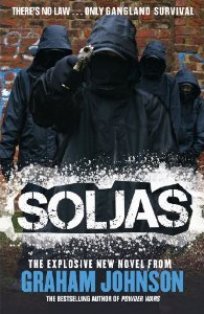
First published in March of 2010, true crime writer Graham Johnson’s debut work of fiction entitled ‘Soljas’ was released at a particular peak in the public’s conception of the youth crime menace that we are told is currently plaguing our streets.
With a healthy background in similarly related true crime publications such as ‘Powder Wars’ (2004), ‘Druglord: Guns, Powder & Pay-offs’ (2006) and ‘The Devil: Britain’s Most Feared Underworld Taxman’ (2007); Johnson seems to be in the ideal situation for writing a compelling and altogether realistic account of gang life within our troubled streets.
DLS Synopsis:
In the city of Liverpool, seventeen-year-old Dylan Olsen has been terrorizing the gangland streets of Liverpool alongside his fellow teenaged gang members. Gang rivalry and warfare is rife; each member becoming more of a family to these dysfunctional youths than their actual family ever were. Indeed, the ‘home life’ of these youths is equally shocking, with broken homes and dysfunctional families creating the obvious weak backbone towards the outcome of these kids.
Their day-to-day lives are filled with emotionless crime sprees to finance their otherwise lavish lifestyles. Drug-dealing, muggings and theft are a daily routine for these youths. Violence, rape and murder go hand-in-hand with their lifestyles; accompanied by the inevitable illegal firearms that turn these vicious youths into extremely dangerous individuals.
When an escalating gang rivalry gets out of hand, Dylan and his fellow gang members - Jay and Nogger get involved in the accidental shooting of an innocent three-year-old girl named Chalina. A major police investigation gets underway after the public outcry at the murder of the child sparks off further governmental action; until finally massive gang exclusion zones are set up within the most troubled areas. Human rights are practically void within these heavily patrolled areas, with a similar state to that of martial law declared.
In and amongst it all, Dylan has found himself someone he actually cares about. However, just as Dylan is finding himself getting close to the girl, his gang members decide to take action. After all, there’s a lot of work to be done out on the streets for some serious sums of money...
DLS Review:
From the very outset, this wildly over-the-top view of the emotionally crippled youths bombards the reader with a veritable cacophony of horrific events that play out the daily lives of these gang members. The no-holds-barred approach towards the graphic depiction of these crimes is shocking to say the least. Within the first few chapters, the reader can’t help but feel disgusted and truly repulsed by the actions of these dysfunctional youths.
The character of Dylan Olsen appears to be the exception to the rule with regards to the emotional and intellectual state of the gang members. A glimmer of actual humanity can be seen within his thinking. Just enough to maybe trigger something more from his life.
As the novel progresses on, so do the levels of violence. Miniature sub-stories are played out from chapter to chapter, allowing the reader to become truly accustomed and immersed within the gangland way of life.
Once the ‘accident’ takes hold of the plot, the storyline shifts down a gear somewhat, taking on a less aggressive stance towards the storytelling. The whole dynamic of the novel twists from this critical point; now with a wider and much broader viewpoint to the gang problem at hand. The government’s reaction (however provoked) is so incredibly over-the-top and preposterous that the novel loses any possible sense of reality that it had held up until then. The characters themselves become an abstracted version of themselves, with a cloudy idea of ‘a prosperous new life’ for them weakly contrived.
The characters themselves are each only basically worked upon; with little time spent on developing the characterisation in face of further crime-fuelled action. The loosely realised storyline is vague in its delivery, only finally knitting together what can be construed as something of ‘closure’ for the tale. The deep buried infuriation and anger felt by the reader throughout the story is never really allowed to truly vent itself, unlike the revenge dealt out in Shaun Hutson's novel ‘Compulsion’ (2001).
The novel plays well with its up-to-date references to recent stories, such as Michael Jackson’s funeral, the Baby P case, Katie Price & Peter Andre’s hugely publicised split etc. However, this will give the novel a quick shelf-life, leaving many references within the tale very dated and potentially baffling in future years.
Sex, drugs, violence and guns go hand-in-hand to form the basis of this shockingly graphic tale. The reality of the issues at hand is utterly tabloid-esque in its nature. Indeed, even the very language that the author utilises throughout the tale seems wildly comical with its over-the-top ‘street’ lingo. This is so much so, that the author has even deemed it necessary to include a glossary of the ‘street’ terms used at the end of the novel.
All in all, the novel is an action packed and truly shocking vision of gang life, portrayed in an exaggerated and over-the-top fashion to deliver the hardest punch possible. However, the multitude of literary flaws within the tale leaves the intended impact slightly off kilter, resulting in a somewhat weak and unbalanced novel.
The novel runs for a total of 240 pages.
© DLS Reviews






